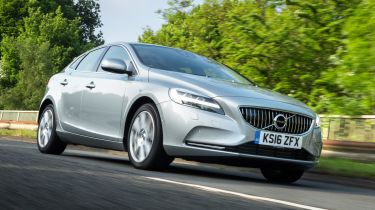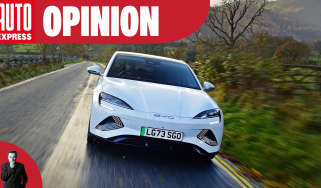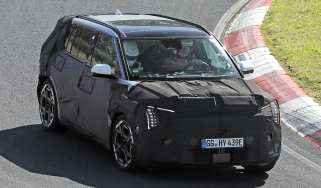Volvo V40 (2012-2019) review
The Volvo V40 is a classy and economical alternative to the Audi A3 Sportback, as long as you don't need maximum boot space

This is a review of a new 2012-2019 Volvo V40. If you are interested in information about a used Volvo V40, please follow the links provided.
The Volvo V40 is a worthy alternative to upmarket family hatchbacks such as the Mercedes A-Class, Audi A3, and VW Golf. It's getting a little long in the tooth now, but the hatchback is still one of Volvo’s biggest sellers, which is due in part to its versatility.
The wide range of engines available, all of which return strong economy and offer decent performance, add to the appeal of the Swedish hatch. On the road, the V40 handles well and refinement inside the cabin lives up to Volvo’s premium brand status.
The diesel models are suited to longer motorway journeys, and what’s more, the V40 has an excellent stereo system and comfortable seats helping make those long journeys more bearable. However, the infotainment system is looking a little behind the times, especially when compared to those in some of its closest rivals.
As hatchbacks go, the V40 isn’t the most spacious five-door on the market. The boot isn’t particularly great for this class and larger passengers in the back will struggle, as space is at a premium. On top of this, insurance is surprisingly expensive, but the sporty R-Design models do hold on to their value well. A big selling point is the advanced safety kit included in the V40, which is some of the best on the market.
Used - available now

2025 Vauxhall
Astra
27,526 milesAutomaticPetrol1.2L
Cash £17,186
2023 Ford
Puma ST
14,782 milesAutomaticPetrol1.0L
Cash £20,699
2023 Nissan
Juke
26,571 milesManualPetrol1.0L
Cash £13,499
2020 Ford
Kuga
30,116 milesManualDiesel1.5L
Cash £15,399The Volvo V40 (and its V40 Cross Country offshoot), is the smallest Volvo for sale in the UK. While the name used to adorn the estate version of the old S40 saloon, the current V40 was launched as an all-new five-door hatchback in 2012. That means it's now one of the longer lived premium hatchbacks on the market, but a competitive price and decent equipment mean it's still worth considering.
Rivals for the V40 initially comprised the Audi A3, BMW 1 Series, Lexus CT and Mercedes A-Class. But as mainstream hatchbacks have moved upmarket, other cars have muscled in on the sector. Chief among them is the Volkswagen Golf, while top-spec versions of the Ford Focus, Vauxhall Astra and Peugeot 308 are hot on the Volvo's heels.
Like the rest of the Volvo range, the V40 comes in Momentum, R-Design and Inscription trims, while the Cross Country is considered a separate model from the rest of the range. All cars are pretty well equipped, with automatic LED headlights, rain sensing wipers, climate control, sat-nav infotainment with DAB radio, Bluetooth and hard drive storage fitted as standard on all models. And with prices ranging from around £23,000 to a touch under £30,000, the V40 falls somewhere between its premium and family hatchback rivals on price, so is reasonably good value considering the kit that you get.
Engines are badged D2 and D3 for the diesels and T2 and T3 for the turbocharged petrols (there have also been D4, T4 and T5 models in the past). These are all 2.0-litre units, unless you choose an auto gearbox for the T2 or T3, in which case you get a 1.5-litre motor. All cars are front-wheel drive, including the Cross Country (you could only ever get the now-discontinued T5 with 4WD), while six-speed manual or auto boxes are offered with all engines.
When the V40 was launched in 2012, it earned the highest Euro NCAP percentage score ever to go with its five-star rating. Its suite of safety kit includes an industry-first pop-up bonnet designed to protect pedestrians in the event of a collision. Even today, the V40 is one of the safest cars for sale in the UK, while an update in 2016 added the 'Thor's Hammer' daytime running light signature first seen on the XC90, bringing Volvo's small hatch into line with the rest of the line-up.
Engines, performance and drive
The Volvo V40 benefits from being based on a development of Ford’s Global C Ford Focus platform. That should mean the V40 handles with similar verve to the Ford Focus Mk3, which is also a derivative of the same platform. However, the V40 uses a lot of bespoke Volvo engineering to ensure it's even safer, while it isn't quite as engaging to drive as the Ford.
That said, the V40 is relatively agile and accurate in the corners, but it errs on the side of safe, rather than exciting. The steering is pretty sharp, however, and body control is pretty tight. It's even relatively comfortable, although the stiffer R-Design models are less forgiving.
The suspension delivers a decent ride on standard models, with good bump absorption around town and a supple ride at speed. Beware that larger wheels do have a negative impact on the V40's ride, though.
The R-Design models have sporty suspension as well as bigger wheels, and both combine to deliver a stiffer ride. This is reflected by the mixed score the V40 has for ride quality in the Driver Power owner satisfaction survey.
Engines
The V40's petrol and diesel engine line-up has been revised over time. At the 2016 update, there were T2, T3 and T5 turbo petrols, and D2, D3 and D4 diesels, but the most powerful of these are no longer offered. All engines are four-cylinder units, and Volvo has gradually phased out the older Ford-sourced engines in favour of its own designs.
The diesels are 2.0-litres in capacity, with 118bhp or 148bhp. The T2 and T3 petrol models get a 2.0-litre engine if you pick the six-speed manual gearbox, but the Geartronic auto comes with a 1.5-litre engine. Either way, the T2 has 120bhp, and the T3 has 150bhp.
The pick of the range are the diesels. Volvo’s latest D2 engine is pretty rattly at idle, but it smooths out at speed and it delivers decent performance. The 148bhp D3 is the pick of the range as it has the best spread of torque (320Nm from 1,750-3,000rpm).
Both diesels are offered with an optional six-speed automatic gearbox; there is a fuel economy penalty, but performance is slightly better and the gearbox itself shifts smoothly and always seems to be in the right gear. The core six-speed manual that’s standard across the V40 range is a decent enough box, but has a bit of a vague and slightly loose shift.
Volvo’s 2.0-litre T2 and T3 petrol engines are impressive. They pull well from low revs: the T2 offers peak torque of 220Nm from just 1,100rpm, all the way to 3,500rpm. As with the diesels, there are six-speed manual or auto gearboxes, but even though the autos are quicker, we prefer the shift of the manual box here.
MPG, CO2 and Running Costs
Volvo's revised diesel engines deliver good fuel economy. The D2 manual has the best economy, and has company car tax-friendly emissions, too. The D3 and D4 are both rated at 74.3mpg, while emissions of 99g/km mean even the most powerful cars are attractive for business users. Add a six-speed auto to any engine and fuel consumption is a little poorer.
The petrol engines are also reasonably efficient, given their torquey turbocharged punch, while again the automatic models are slightly worse for fuel economy and produce higher emissions.
As for running costs, long service intervals and Volvo’s generally strong reliability should mean the V40 costs less to own than some of Volvo’s larger models. Driver Power owners’ experience is certainly encouraging: they vote the V40 the 15th best car for overall running costs, so there should be no nasty surprises for your wallet.
Insurance groups
Perhaps reflecting its semi-premium status, insurance groups for the V40 are a little higher than the mainstream norm. A base T2 Momentum comes in at group 18, whereas a similar-power Ford Focus 1.0 Ecoboost starts at group 12. There's a bit of a step up in ratings from T2 to T3, which starts in Group 24 in R-Design trim.
It's a similar story for the diesels, as the D2 starts in group 19, moves to group 20 in R-Design trim, then the R-Design D3 starts in group 25. The Cross Country models are in similar insurance group, but it should be easier to repair their scuff-resistant panels.
Depreciation
Retained values for the Volvo V40 are reasonable, if not outstanding. There's a spread of around 38-46 per cent in retained values after three years, with the petrol cars being the best performers of the range. Interestingly, even though the used market craves an SUV, it's clear that buyers can look beyond the Cross Country's styling and see it's just a stylised hatchback. As a result, residuals are poorer for these models.
Compared to rivals, the V40 isn't a great performer. The equally ageing Audi A3 Sportback has better retained values in the mid-40 per cent region, while even the latest Ford Focus is a better-performing model.
To get an accurate valuation on a specific model check out our free car valuation tool...
Interior, design and technology
The V40 has an interior that's characteristic of Volvo. There are plenty of soft-touch materials and classy metal trim, while higher spec Inscription and R-Design cars have some stylish design options for the neat ‘floating’ centre console.
There are a lot of buttons on the dash, though: the centre console is packed with them, and it’s a slight case of form over function as some buttons are tricky to find at a glance.
Volvo’s ignition key is also compromised. It slots in high on the dash out of harm’s way (so knees can’t hit it in a crash), but if you have a large keyfob, especially a metal one, it can rattle irritatingly against the dashboard and scratch it, too. You also have to press a button after inserting the keyfob to start the car. Keyless Drive, which is part of the £1,500 Xenium pack, is an option we’d recommend.
There’s a lot of technology packed into the V40 – not least the active safety tech. City Safety autonomously helps you avoid accidents at city speeds and a speed limiter stops speeds creeping up. All cars now get sat-nav as standard, while the optional Sensus Connect system adds voice control, a larger seven-inch screen and connected web apps and internet browser.
Sat-nav, stereo and infotainment
The V40 uses Volvo’s previous-generation sat-nav system, rather than the latest touchscreen setup first seen in the XC90. As such, it’s very fiddly and awkward to use, requiring multiple twists of a dial and presses of a confirm button to set destinations. It’s old technology, and it shows.
The system itself works reasonably well and the mapping is clear from the high-res screen. The display itself isn’t the largest, however, as space is restricted due to the fact that it’s integrated into the dashboard rather than standing proud from it, like Mercedes does in its A-Class hatch. There's no touchscreen functionality, though.
Volvo offers its Sensus Connect system to go with the sat-nav for around £500. This adds a hard drive for music storage, European mapping, TMC traffic message channel and lifetime annual map updates.
Volvo has a well deserved reputation for excellent stereo quality, and the V40 is no exception. Even the standard High Performance Sound system has excellent depth, definition and clarity, although again adding the Sensus Connect option brings the optional Harman/Kardon 130W ‘sound stage’ system for even greater sound quality.
Practicality, comfort and boot space
The V40 does a good job of feeling like a larger, more expensive Volvo inside. The front seats are comfortable, just like any other Volvo, with a supportive design that doesn't leave you with aches and pains. The Driver Power survey reflects this, with the V40 scoring an outstanding fourth place overall for seat comfort. It's a pity that another Volvo trademark, heated seats, are reserved for the options list (as part of the Winter Pack, costing between £350-£500 depending on trim).
Interior stowage is a mixed bag. There are lots of cubbies, including a tray behind Volvo’s ‘floating’ centre console, but some are on the small side: the door bins, for example, won’t easily hold a bottle of water. Luckily, the sliding box between the front seats contains a holder for two cups.
Dimensions and size
Although it looks quite large for a hatch on the outside, the V40 isn’t one of the roomiest models. Clearly all the Volvo-specific safety engineering to reinforce the Ford-derived platform has eaten up a little of the room normally reserved for passengers.
The front seats are mounted high, perhaps a little too high in models with electric seats, which can impact a little on headroom. The pedals feel a touch tight too, and the V40 isn’t as open plan as models such as the Volkswagen Golf.
With bulky door panels and sporty, raked A-pillars, the V40 doesn’t feel overly spacious but it does feel extremely safe and reassuring as a result.
Leg room, head room & passenger space
The V40 is a little on the cramped side in the rear. Getting in and out can be a bit awkward, due to the size of the front seats which can get in the way of your feet. Once in, passengers will find comfortable seats but not an abundance of space.
Headroom is particularly tight for taller occupants, and if those in the front are tall, they may have to slide their seats forward a bit to free up kneeroom in the back – not something you normally expect in a family five-door.
It is very nicely trimmed in the rear though, and children will find the well-padded, plush rear bench seat a very nice place to while away the hours. There’s an added bonus too – optional heated rear seats are available, an option that costs around £200 and will transform winter comfort for those in the back.
Boot space
The boot of the Volvo V40 is a bit disappointing compared to other five-door family hatchbacks. Seats up, the diesel model offers just 335 litres, compared to the 380 litres of a Volkswagen Golf (curiously, the petrol is slightly smaller still, on 324 litres).
Seats folded, the diesel expands to 1,032 litres, or 1,021 litres for the petrol cars. That’s with luggage loaded to the roof, too: in comparison, a Volkswagen Golf offers 1,270 litres of space with the seats down – a full 238 litres more space than the V40.
The stylish rear end means the boot opening is a bit on the narrow side, and the sill is a little high. The boot is very nicely trimmed though, with lashing points in the sides to help secure luggage, and the rear seats do fold fully flat for loading bulky objects. Just be careful when you close the tailgate – the rear screen is rather steeply raked.
Reliability and Safety
The Volvo V40 is an extremely safe car. In 2012, Euro NCAP awarded it as the safest car of the year, as it scored a best-ever 98 per cent for adult occupant protection and a 100 per cent score for safety assist.
Clever innovations include a bonnet airbag, a feature that’s standard across the range. It’s this that’s key to the V40’s superb 88 per cent pedestrian protection score. The only relatively poor score is the car’s 75 per cent score for child occupant protection, although rivals still have lower scores than that.
Geely-owned Volvo has been impressing UK motorists for a while now, although it only really ranks in the middle of our Driver Power manufacturer standings. The V40 has occasionally appeared in the survey of cars for sale, but hasn't ranked higher than 16th in its time on sale. One thing that has remained consistent is that owners have rated it highly for seat comfort and running costs, but not so well for ride quality, performance or practicality.
Warranty
The V40 comes as standard with a three-year, 60,000-mile warranty, combined with a three-year unlimited mileage paintwork warranty. It also has an eight-year warranty against rust.
Part of the Volvo new car warranty is three years’ Volvo Assistance roadside breakdown cover – for both the UK and Europe. If you have your V40 serviced at a Volvo dealer, it is automatically extended after three years: if you don’t, 12 months’ cover costs around £100.
Servicing
Service intervals for the latest range of Volvo engines is annually or every 18,000 miles – this is a boost from the older Ford engines, which had shorter mileage service intervals. Volvo dealers are generally competitive on pricing, and sample quotes can be calculated via a tool on the firm’s website, so you don't have to ring around to chase them.



